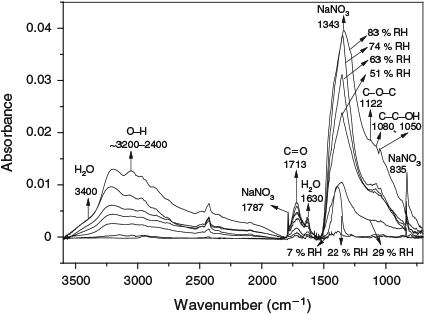SOA formation from ethyne
组内消息 2016-02-14
High light:Ethyne is the lightest of the non-methane hydrocarbons, whose oxidation product, glyoxal, is an important precursor of secondary organic aerosol. This study explores the effects of relative humidity on the formation of secondary organic aerosol under irradiation in the presence of nitrogen oxides and sodium chloride. Results show that relative humidity can enhance aerosol formation, which provides evidence of the contribution of ethyne to organic particles.
FTIR spectra of SOA from ethyne
The heterogeneous photochemical oxidation of ethyne was investigated under different relative humidity (RH) conditions in the presence of nitrogen oxides and sodium chloride in a self-made indoor smog chamber. The purpose was to study the influence of RH on the formation of secondary organic aerosol (SOA) from C2H2. Through the experiments, we found that SOA was rarely formed at <22% RH in the presence of NaCl seed particles, and that SOA began to be formed at ≥29 % RH in the presence of NaCl, which shows the importance of RH in the formation of SOA. The yield of SOA (YSOA) from C2H2 was 0.2 % at 51 % RH, and increased by a factor of 17.5 as RH reached 83%. The SOA yield increased with increasing RH. The geometric mean diameter of the particles increased by a factor of 1.17, 1.22, 1.28 and 1.51 at a RH of 51, 63, 74 and 83% respectively at the end of the experiment, indicating that the growth of the particle size also increased with increasing RH. Analysis of the SOA with Fourier-transform infrared (FTIR) spectrometry indicated that the particles generated from C2H2 contained the functional groups –OH, C=O, C–O–C and C–C–OH, for whose absorption peaks increase with increasing RH.
Ge Shuangshuang, Xu Yongfu, Jia Long (2016) Secondary organic aerosol formation from ethyne in the presence of NaCl in a smog chamber. Environmental Chemistry 13, 699-710.
Full TEXT




